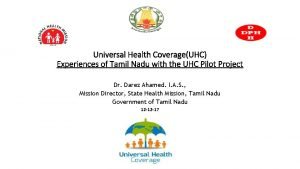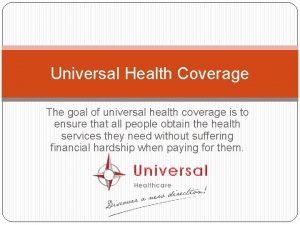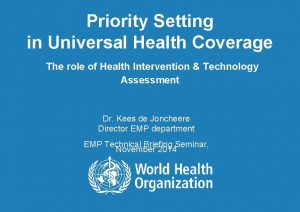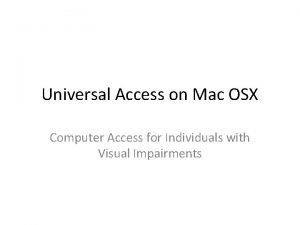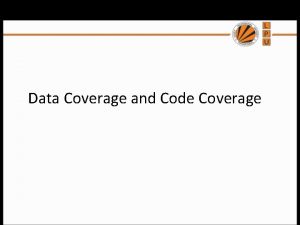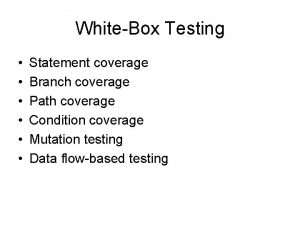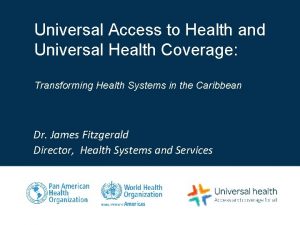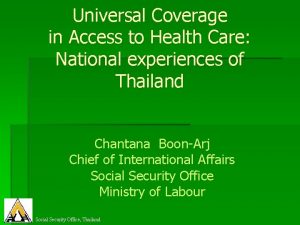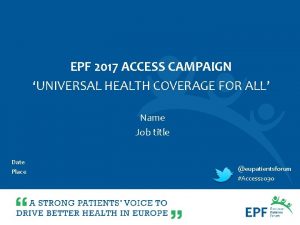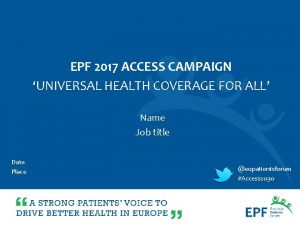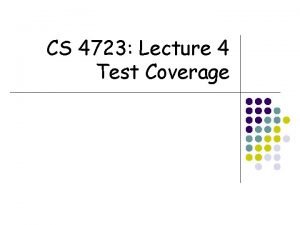From universal access to universal coverage How does














- Slides: 14

From universal access to universal coverage How does health insurance mechanisms and HIV interact: Overview of country experience Erik Lamontagne, Ole Doetinchem, Robert Greener Systems Integration, UNAIDS Geneva Bridging the Divide: Interdisciplinary Partnerships for HIV and Health Systems Vienna, Austria, 16 -17 July 2010

Coverage of AIDS services

Different types of mechanisms private health insurance social health insurance public tax-funded provision

The review of country experiences • Questionnaire on country situation: how is the overall health insurance and how HIV is eventually integrated • Excellent response rate (65/71) countries • Country analysed in terms of their vulnerability • Vulnerability level: incorporates proxy measures of – Poverty rate – Extend of the informal economy (see World Social Security Report 2010)

Country characteristics Government health expenditure Classification using vulnerability index is coherent with usual characteristics No clear trend of HIV prevalence Among vulnerability groups of countries

Health insurance coverage Blue: % country including health insurance Green: proportion of providing ART coverage Orange: proportion of SHI providing PMTCT

The case of Ghana

The case of South Africa

Lessons to draw (1) • Introducing health insurance is not an automatic recipe for increasing revenue collection for health or HIV • Integrating HIV services in SHI: more challenging for low income countries ( f(prevalence) ) • Not a fatality: Ghana, South Africa and Rwanda • Countries that choose to include HIV services in SHI are mainly those already having a functioning health insurance system in place.

Lessons to draw (2) • The review shows that including HIV = essentially a political decision • Possibility to progressively increase coverage (pop, cost, services) • External aid, incl. HIV financing can support (and subsidise) progressive integration of HIV in SHI

Thank you contact: Erik Lamontagne: lamontagnee@unaids. org Geneva, UNAIDS

Annexe Economic share of government

Health expenditures and GDP (most of ) Sub Saharan Africa Van der Gaag et al, Economics Reference Group, Dec 2009

Projection of health funding • GDP per capita is an almost perfect predictor of health expenditure per capita • The estimated income elasticity is higher than zero and close to or even higher than one. • This implies that health is regarded more as a “luxury good” than as a necessity (by the aggregate populations of most countries) • Based on projections of health funding to 2030, Van der Gaag et al (2009) concludes that: – over time (relatively fast growing) middle income countries may have sufficient funding… – …but (relatively slow growing) low income countries will need significant financial support for years to come.
 Uhc op app
Uhc op app Goals of universal health coverage
Goals of universal health coverage Dimensions of universal health coverage
Dimensions of universal health coverage Universal access mac
Universal access mac Online platforms sites and content
Online platforms sites and content Trends in ict assistive media examples
Trends in ict assistive media examples Terminal access controller access-control system
Terminal access controller access-control system Terminal access controller access-control system
Terminal access controller access-control system Theme vs topic
Theme vs topic Condition coverage
Condition coverage Current cash debt coverage ratio
Current cash debt coverage ratio Channel of distribution examples
Channel of distribution examples Fault coverage in vlsi
Fault coverage in vlsi Cash debt coverage
Cash debt coverage The number of test of adequacy is
The number of test of adequacy is
